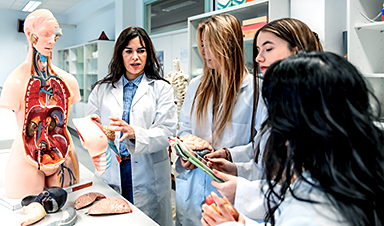A vaccine that targets inflamed brain cells associated with Alzheimer’s disease could possibly modify or prevent the disease, according to preliminary research.
- A novel vaccine that targets a protein involved in Alzheimer’s disease helped eliminate toxic cells in mice with the condition.
- After vaccination, the mice had fewer amyloid plaques and less inflammation in brain tissue and showed improvement in behavior and awareness.
A novel vaccine that targets inflamed brain cells associated with Alzheimer’s disease may hold the key to potentially preventing or modifying the course of the disease, according to preliminary research presented at the American Heart Association’s Basic Cardiovascular Sciences Scientific Sessions 2023. The meeting is in Boston, July 31–August 3, 2023, and offers the latest research on innovations and discovery in cardiovascular science.
Previously, researchers at Juntendo University Graduate School of Medicine in Tokyo, Japan developed a vaccine to eliminate senescent cells expressing senescence-associated glycoprotein (SAGP) — a senolytic vaccine that improved various age-related diseases including atherosclerosis and Type 2 diabetes in mice. Another study also found that SAGPs are highly expressed in glial cells in people with Alzheimer’s disease. Based on the findings from these studies, the researchers tested this vaccine in mice to target SAGP-overexpressed cells to treat Alzheimer’s disease.
Alzheimer’s Research and Test Results
“Alzheimer’s disease now accounts for 50% to 70% of dementia patients worldwide. Our study’s novel vaccine test in mice points to a potential way to prevent or modify the disease. The future challenge will be to achieve similar results in humans,” said lead study author Chieh-Lun Hsiao, Ph.D., a post-doctoral fellow in the department of cardiovascular biology and medicine at Juntendo University Graduate School of Medicine in Tokyo. “If the vaccine could prove to be successful in humans, it would be a big step forward towards delaying disease progression or even prevention of this disease.”
In this study, the research team created an Alzheimer’s disease mouse model that mimics a human brain and simulates amyloid-beta-induced Alzheimer’s disease pathology. To test the efficacy of the SAGP vaccine, the mice were treated with a control vaccine or the SAGP vaccine at two and four months old. Usually, people in the late stage of Alzheimer’s lack anxiety, which means they are not aware of the things around them. The mice who received the vaccine had anxiety, which means that they were more cautious and more aware of things around them – a sign researchers say could indicate a lessening of the disease. In addition, several inflammatory biomarkers of Alzheimer’s disease were also reduced.
Key Findings
The study found:
- The SAGP vaccine significantly reduced amyloid deposits in brain tissue located in the cerebral cortex region, which is responsible for language processing, attention, and problem-solving.
- The astrocyte cell (the most abundant type of glial cell in the brain and a specific inflammatory molecule) was shown to be decreased in size in mice receiving the vaccine. A reduction in other inflammatory biomarkers was also seen, implying that inflammation in the brain improved in response to the SAGP vaccine.
- A behavior test (maze-type device) on the mice at six months old revealed that those that received the SAGP vaccine responded significantly better to their environment than those who received the placebo vaccine. The SAGP-vaccinated mice tended to behave like normal healthy mice and exhibited more awareness of their surroundings.
- The SAGP protein was shown to be located very near to specialized brain cells called microglia, which play a role in the immune defense of the central nervous system. Microglia help clear damaging plaque formed by proteins; however, they also trigger brain inflammation that can damage neurons and worsen cognitive decline in a person, which could be one of the causes of Alzheimer’s disease development.
Alzheimer’s Disease Mechanism
In Alzheimer’s disease, an accumulation of brain proteins called amyloid beta peptides clump together forming plaques that collect between neurons and disrupt cell function, according to the National Institute on Aging, a division of the National Institutes of Health.
Vascular problems may also lead to a breakdown of the blood-brain barrier, which usually protects the brain from harmful agents while allowing access for glucose and other necessary factors. This faulty blood-brain barrier prevents glucose from reaching the brain and prevents the clearing away of toxic beta-amyloid and proteins, which results in chronic inflammation and Alzheimer’s disease progression.
Concluding Remarks
“Earlier studies using different vaccines to treat Alzheimer’s disease in mouse models have been successful in reducing amyloid plaque deposits and inflammatory factors, however, what makes our study different is that our SAGP vaccine also altered the behavior of these mice for the better,” Hsiao said.
According to the researchers, previous research suggests that the SAGP protein is highly elevated in microglia, which means that microglia are very important cells to target in Alzheimer’s disease. Hsiao said, “By removing microglia that are in the activation state, the inflammation in the brain may also be controlled. A vaccine could target activated microglia and remove these toxic cells, ultimately repairing the deficits in behavior suffered in Alzheimer’s disease.”
According to the 2023 American Heart Association Statistical Update, about 3.7 million Americans, ages 30 years and older, had Alzheimer’s disease in 2017, and this number is projected to increase to 9.3 million by 2060.
BCVS is one of the largest meetings in the world dedicated to fundamental and translational research to improve heart health, a goal that the pandemic has only made more critical. Presented by the American Heart Association’s Basic Cardiovascular Sciences Council, the 2023, in-person conference attracts leading researchers in fields such as microRNAs, cardiac gene and cell therapy, cardiac development and also includes tissue engineering and iPS cells.
News
New Once-a-Week Shot Promises Life-Changing Relief for Parkinson’s Patients
A once-a-week shot from Australian scientists could spare people with Parkinson’s the grind of taking pills several times a day. The tiny, biodegradable gel sits under the skin and releases steady doses of two [...]
Weekly injectable drug offers hope for Parkinson’s patients
A new weekly injectable drug could transform the lives of more than eight million people living with Parkinson's disease, potentially replacing the need for multiple daily tablets. Scientists from the University of South Australia [...]
Most Plastic in the Ocean Is Invisible—And Deadly
Nanoplastics—particles smaller than a human hair—can pass through cell walls and enter the food web. New research suggest 27 million metric tons of nanoplastics are spread across just the top layer of the North [...]
Repurposed drugs could calm the immune system’s response to nanomedicine
An international study led by researchers at the University of Colorado Anschutz Medical Campus has identified a promising strategy to enhance the safety of nanomedicines, advanced therapies often used in cancer and vaccine treatments, [...]
Nano-Enhanced Hydrogel Strategies for Cartilage Repair
A recent article in Engineering describes the development of a protein-based nanocomposite hydrogel designed to deliver two therapeutic agents—dexamethasone (Dex) and kartogenin (KGN)—to support cartilage repair. The hydrogel is engineered to modulate immune responses and promote [...]
New Cancer Drug Blocks Tumors Without Debilitating Side Effects
A new drug targets RAS-PI3Kα pathways without harmful side effects. It was developed using high-performance computing and AI. A new cancer drug candidate, developed through a collaboration between Lawrence Livermore National Laboratory (LLNL), BridgeBio Oncology [...]
Scientists Are Pretty Close to Replicating the First Thing That Ever Lived
For 400 million years, a leading hypothesis claims, Earth was an “RNA World,” meaning that life must’ve first replicated from RNA before the arrival of proteins and DNA. Unfortunately, scientists have failed to find [...]
Why ‘Peniaphobia’ Is Exploding Among Young People (And Why We Should Be Concerned)
An insidious illness is taking hold among a growing proportion of young people. Little known to the general public, peniaphobia—the fear of becoming poor—is gaining ground among teens and young adults. Discover the causes [...]
Team finds flawed data in recent study relevant to coronavirus antiviral development
The COVID pandemic illustrated how urgently we need antiviral medications capable of treating coronavirus infections. To aid this effort, researchers quickly homed in on part of SARS-CoV-2's molecular structure known as the NiRAN domain—an [...]
Drug-Coated Neural Implants Reduce Immune Rejection
Summary: A new study shows that coating neural prosthetic implants with the anti-inflammatory drug dexamethasone helps reduce the body’s immune response and scar tissue formation. This strategy enhances the long-term performance and stability of electrodes [...]
Scientists discover cancer-fighting bacteria that ‘soak up’ forever chemicals in the body
A family of healthy bacteria may help 'soak up' toxic forever chemicals in the body, warding off their cancerous effects. Forever chemicals, also known as PFAS (per- and polyfluoroalkyl substances), are toxic chemicals that [...]
Johns Hopkins Researchers Uncover a New Way To Kill Cancer Cells
A new study reveals that blocking ribosomal RNA production rewires cancer cell behavior and could help treat genetically unstable tumors. Researchers at the Johns Hopkins Kimmel Cancer Center and the Department of Radiation Oncology and Molecular [...]
AI matches doctors in mapping lung tumors for radiation therapy
In radiation therapy, precision can save lives. Oncologists must carefully map the size and location of a tumor before delivering high-dose radiation to destroy cancer cells while sparing healthy tissue. But this process, called [...]
Scientists Finally “See” Key Protein That Controls Inflammation
Researchers used advanced microscopy to uncover important protein structures. For the first time, two important protein structures in the human body are being visualized, thanks in part to cutting-edge technology at the University of [...]
AI tool detects 9 types of dementia from a single brain scan
Mayo Clinic researchers have developed a new artificial intelligence (AI) tool that helps clinicians identify brain activity patterns linked to nine types of dementia, including Alzheimer's disease, using a single, widely available scan—a transformative [...]
Is plastic packaging putting more than just food on your plate?
New research reveals that common food packaging and utensils can shed microscopic plastics into our food, prompting urgent calls for stricter testing and updated regulations to protect public health. Beyond microplastics: The analysis intentionally [...]





















